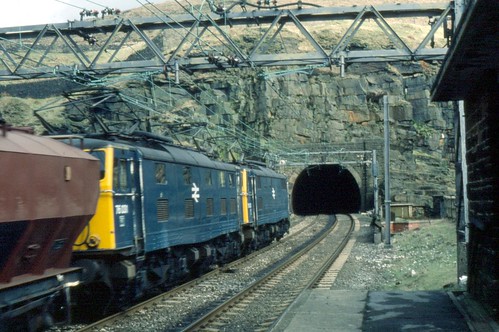Manchester London Road station (since renamed Manchester Piccadilly) was opened as a railway terminus in 1842 to serve two main line railways: the Manchester and Birmingham (from the south) and the Sheffield, Ashton-under Lyne and Manchester Railway (from the east). The Sheffield, Ashton-under Lyne and Manchester Railway had opened as far as Godley by 1842 and, when fully opened, was always a challenging route, as the gradient diagram below reveals. The single-bore Woodhead Tunnels, each 3 miles long, added to the difficulties. For more about the tunnels, see the Wikipedia article here and the 'Forgotten Relics of an Enterprising Age' article here.

Click for larger view
Gradient Diagram: Sheffield - Manchester via Woodhead
In addition to passenger traffic, the line was an important freight route, conveying coal west across the Pennines to the factories of Lancashire. Coal originated both further south in the Nottinghamshire coalfield and from the South Yorkshire mines. Marshalling yards at Wath, north of Sheffield, consolidated the South Yorkshire traffic and a branch line from Wath joined the main Manchester to Sheffield line just east of Penistone. The branch from Wath included the fierce Worsborough Bank with a gradient of around 1 in 40 for which Gresley provided his massive U1 2-8-0+0-8-2 Beyer-Garratt as a banking engine (see the LNER Encyclopedia here for a brief description).
The success of the electrification of the Manchester South Junction & Altrincham railway in 1931 (briefly described here) encouraged the L.N.E.R. to proceed with their plans for electrification of the main line between Manchester and Sheffield via Woodhead and the branch to Wath but after the first locomotive had been built, World War II suspended completion.
After World War II, the long-planned scheme introduced main line overhead electrification at 1500 volts d.c. Full electric operation throughout the line was deferred until completion of the replacement double-line Woodhead tunnel large enough to accommodate the overhead line equipment. The double-line tunnel opened in 1953 and the majority of the electrified line finally opened in 1954, providing a modernised freight and passenger route across the Pennines. There's a Wikipedia article here and a Metropolitan Vickers publicity brochure from 1954 on the Railways Archive website here.
Between 1971 and 1973, a massive coal-fired power station was commissioned at Fiddler's Ferry, near Warrington. There's a Wikipedia article here. This power station produced a staggering 1,989 MW of power from its four 500 MW alternators. The Manchester-Sheffield-Wath route was used to transport coal to this facility.
Plans to rationalise British Railways by eliminating duplicate routes originally slated the former Midland Railway Hope Valley line from Manchester to Sheffield for closure with the Manchester-Sheffield-Wath line being retained. But the plans were reversed and the Manchester-Sheffield-Wath line was closed in 1981. Following closure, the later double-line Woodhead Tunnel and the two original tunnels have been re-purposed for National Grid power cables.

Class 76 locomotives 76033 and 76031 at Woodhead on 24th March 1981 (Photo: Kevin Cooke CC BY-SA 3.0)
Fiddler's Ferry Power Station continued in operation after closure of the Manchester-Sheffield-Wath line in 1981, obtaining coal via other routes. Final decommissioning of the power station was not until 2020.

Fiddler's Ferry decommissioned power station viewed from train approaching Runcorn in 2022
Electric Traction
Two classes of electric locomotive and one class of electric multiple unit were produced for the line. Freight trains were hauled by one or two of the class of fifty-eight 'EM1' Bo-Bo locomotives. Express passenger trains were hauled by the class of seven 'EM2' Co-Co locomotives until they were withdrawn in 1968, after which 'EM1' locomotives were used until closure of the line. Eight 3-car Electric Multiple Units were built for suburban services from Manchester as far as Hadfield.
EM1:

Click for larger view
'EM1' Electric Locomotive (from 'Metro-Vick Locos 1954' in Railway Archive)
The 'EM1' (later class 76) locomotive had four 467 horse power Metropolitan Vickers d.c. motors. Pair of motors on each bogie were permanently in series. For starting, all four motors were in series with 15 starting resistors in series. 'Notching-up' progressively removed these resistors. The two pairs of motors were then placed in parallel with the starting resistors re-instated. Further 'notching-up' progressively removed the resistors. Final acceleration was achieved by weakening motor fields by switching-in a resistor. The drawing below includes the mechanical drawing, wiring drawing and control table.
See also the Wikipedia article on Class 76 here and LNER Encyclopedia article here.
EM2:
The 'EM2' was designed for 90 mph running, not possible on the Manchester-Sheffield-Wath route and was intended to serve as the prototype for use on further overhead d.c. electrified schemes which did not occur because of the decision to use overhead 25 kV a.c. in the future. See the Wikipedia article on Class 77 here and LNER Encyclopedia article on EM2 here.
Class 506:
See the Wikipedia article here and LNER Encyclopedia article here.
Book References
[1] ‘British Electric Trains’ by H. W. A. Linecar (Ian Allan) 2nd edition 1949.
[2] ‘DC Electric Trains and Locomotives in the British Isles’ by R. L. Vickers (David & Charles) ISBN 0-7153-8674-3.
Related posts on other websites
Manchester–Sheffield–Wath electric railway (Wikipedia).
Metro-Vick Locos 1954 (Railway Archive).
British Rail Class 76 (Wikipedia).
British Rail Class 77 (Wikipedia).
British Rail Class 506 (Wikipedia).
The Electric Bo-Bo Class EM1 (BR Class 76) Locomotives (LNER Encyclopedia).
The Electric Co-Co Class EM2 (BR Class 77) Locomotives (LNER Encyclopedia).
The Glossop Line Class 506 Electric Multiple Units (LNER Encyclopedia).
LNER Class U1 (Wikipedia)
The U1 Garratt (LNER Encyclopedia)
Woodhead Tunnel (Wikipedia)
The story of the Woodhead Tunnels (Forgotten Relics)
Fiddler's Ferry Power Station
Related posts on this website
Manchester South Junction & Altrincham Railway
Class 'EM1' D.C. Electric
Class 'EM2' D.C. Electric
